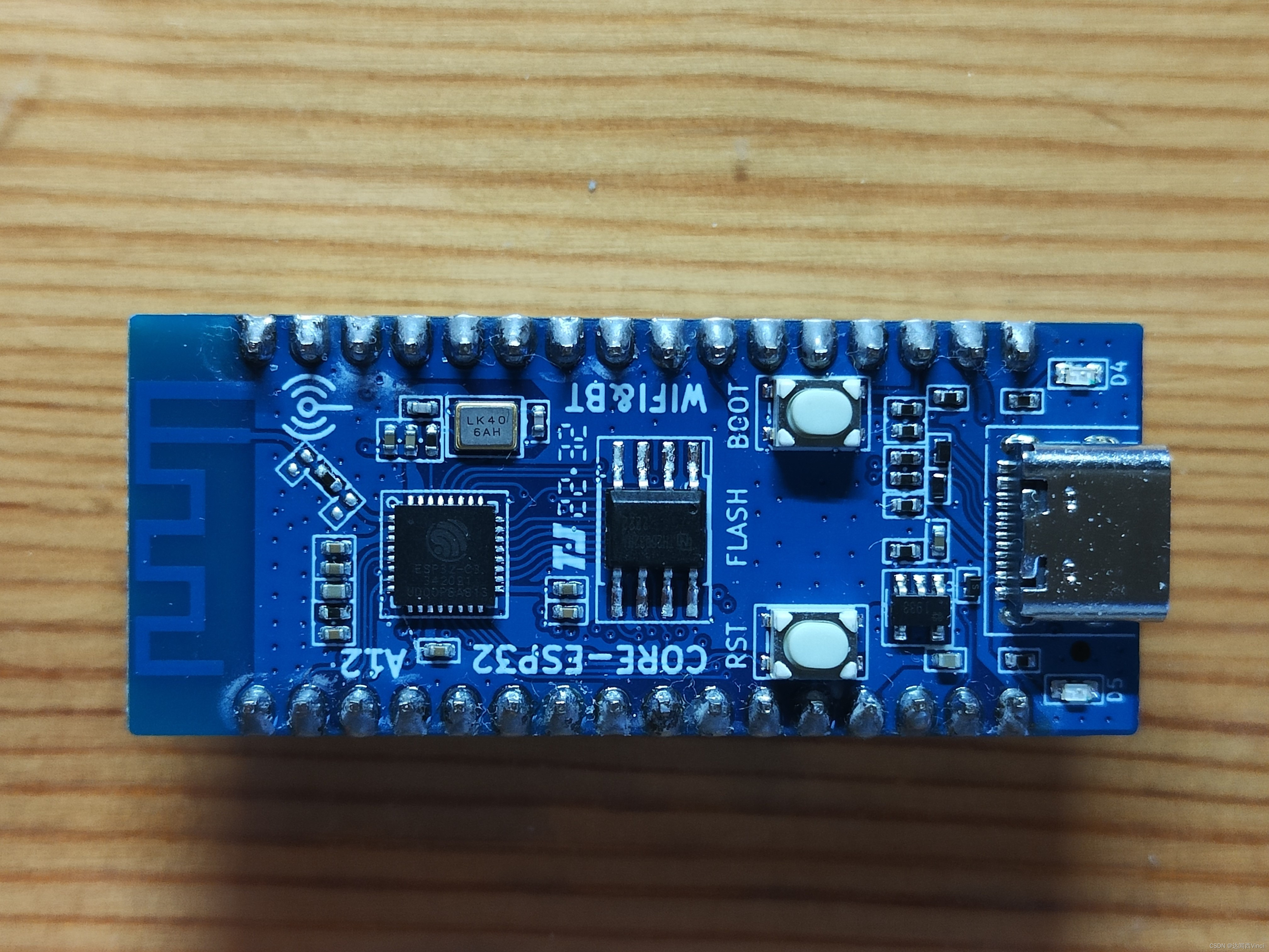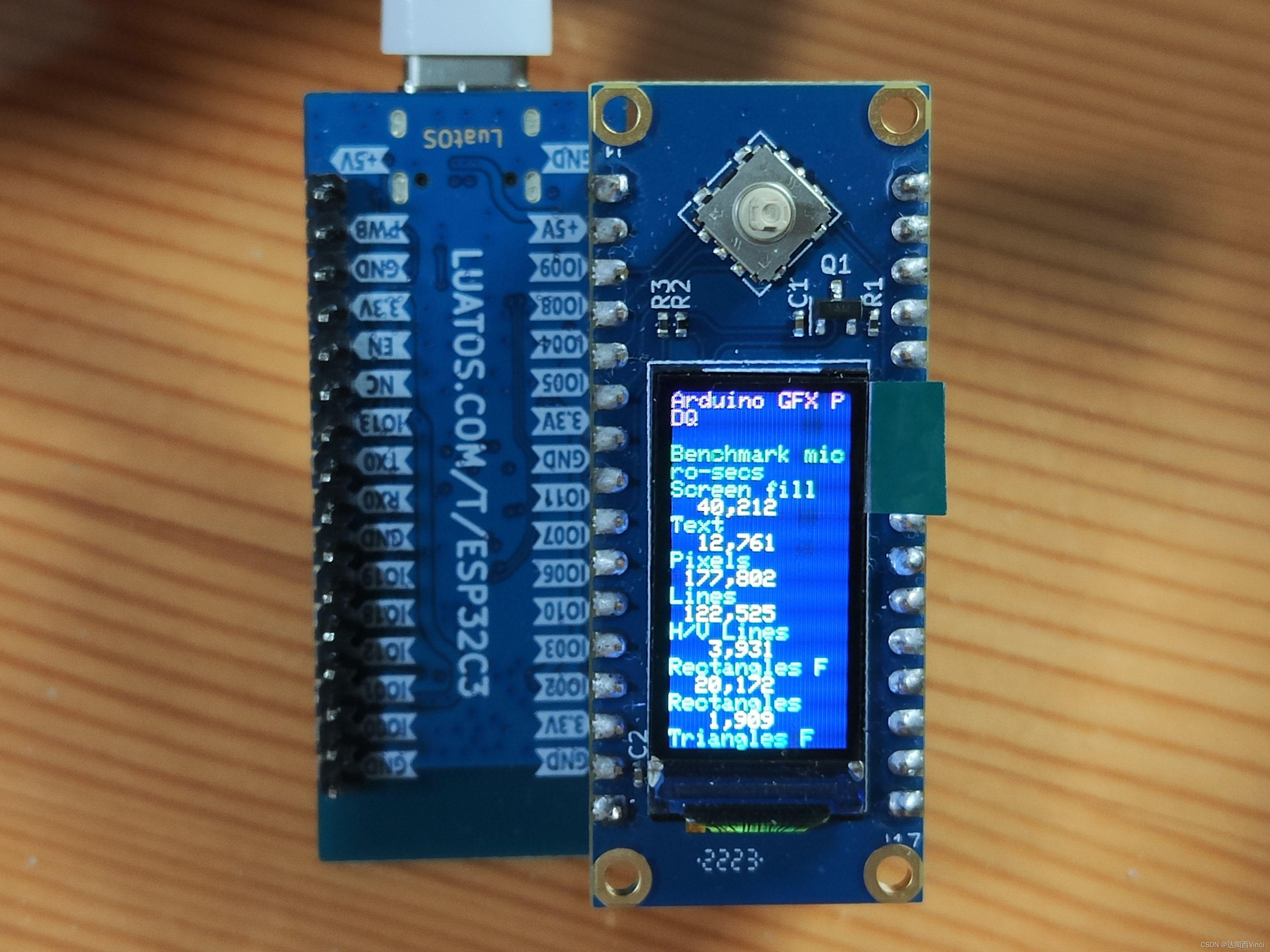1.开发板
合宙esp32 c3,主频160mhz。

2.显示屏
合宙0.96寸lcd,驱动为st7735。

3.代码
这是开发板的定义,如果要修改开发板则需要去示例程序PDQ graphicstest中寻找。
Arduino_DataBus *bus = new Arduino_ESP32SPI(6 /* DC */, 7 /* CS */, 2 /* SCK */, 3 /* MOSI */, GFX_NOT_DEFINED /* MISO */);根据屏幕驱动和分辨率选择屏幕定义,修改的话同样要去PDQ graphicstest寻找。
Arduino_GFX *gfx = new Arduino_ST7735(bus, 10 /*RST*/, 0 /* rotation */, false /* IPS */, 80 /* width */, 160 /* height */, 24 /* col offset 1 */, 0 /* row offset 1 */, 24 /* col offset 2 */, 0 /* row offset 2 */);#define SPI_FREQUENCY 40000000
#include <Arduino_GFX_Library.h>
Arduino_DataBus *bus = new Arduino_ESP32SPI(6 /* DC */, 7 /* CS */, 2 /* SCK */, 3 /* MOSI */, GFX_NOT_DEFINED /* MISO */);
Arduino_GFX *gfx = new Arduino_ST7735(bus, 10 /*RST*/, 0 /* rotation */, false /* IPS */, 80 /* width */, 160 /* height */, 24 /* col offset 1 */, 0 /* row offset 1 */, 24 /* col offset 2 */, 0 /* row offset 2 */);
int32_t w, h, n, n1, cx, cy, cx1, cy1, cn, cn1;
uint8_t tsa, tsb, tsc, ds;
void setup()
{
Serial.begin(115200);
// Serial.setDebugOutput(true);
// while(!Serial);
Serial.println("Arduino_GFX library Test!");
#ifdef GFX_PWD
pinMode(GFX_PWD, OUTPUT);
digitalWrite(GFX_PWD, HIGH);
#endif
gfx->begin();
// gfx->begin(80000000); /* specify data bus speed */
w = gfx->width();
h = gfx->height();
n = min(w, h);
n1 = n - 1;
cx = w / 2;
cy = h / 2;
cx1 = cx - 1;
cy1 = cy - 1;
cn = min(cx1, cy1);
cn1 = cn - 1;
tsa = ((w <= 176) || (h <= 160)) ? 1 : (((w <= 240) || (h <= 240)) ? 2 : 3); // text size A
tsb = ((w <= 272) || (h <= 220)) ? 1 : 2; // text size B
tsc = ((w <= 220) || (h <= 220)) ? 1 : 2; // text size C
ds = (w <= 160) ? 9 : 12; // digit size
#ifdef GFX_BL
pinMode(GFX_BL, OUTPUT);
digitalWrite(GFX_BL, HIGH);
#endif
}
static inline uint32_t micros_start() __attribute__((always_inline));
static inline uint32_t micros_start()
{
uint8_t oms = millis();
while ((uint8_t)millis() == oms)
;
return micros();
}
void loop(void)
{
Serial.println(F("Benchmark\tmicro-secs"));
int32_t usecFillScreen = testFillScreen();
serialOut(F("Screen fill\t"), usecFillScreen, 100, true);
int32_t usecText = testText();
serialOut(F("Text\t"), usecText, 3000, true);
int32_t usecPixels = testPixels();
serialOut(F("Pixels\t"), usecPixels, 100, true);
int32_t usecLines = testLines();
serialOut(F("Lines\t"), usecLines, 100, true);
int32_t usecFastLines = testFastLines();
serialOut(F("Horiz/Vert Lines\t"), usecFastLines, 100, true);
int32_t usecFilledRects = testFilledRects();
serialOut(F("Rectangles (filled)\t"), usecFilledRects, 100, false);
int32_t usecRects = testRects();
serialOut(F("Rectangles (outline)\t"), usecRects, 100, true);
int32_t usecFilledTrangles = testFilledTriangles();
serialOut(F("Triangles (filled)\t"), usecFilledTrangles, 100, false);
int32_t usecTriangles = testTriangles();
serialOut(F("Triangles (outline)\t"), usecTriangles, 100, true);
int32_t usecFilledCircles = testFilledCircles(10);
serialOut(F("Circles (filled)\t"), usecFilledCircles, 100, false);
int32_t usecCircles = testCircles(10);
serialOut(F("Circles (outline)\t"), usecCircles, 100, true);
int32_t usecFilledArcs = testFillArcs();
serialOut(F("Arcs (filled)\t"), usecFilledArcs, 100, false);
int32_t usecArcs = testArcs();
serialOut(F("Arcs (outline)\t"), usecArcs, 100, true);
int32_t usecFilledRoundRects = testFilledRoundRects();
serialOut(F("Rounded rects (filled)\t"), usecFilledRoundRects, 100, false);
int32_t usecRoundRects = testRoundRects();
serialOut(F("Rounded rects (outline)\t"), usecRoundRects, 100, true);
#ifdef CANVAS
uint32_t start = micros_start();
gfx->flush();
int32_t usecFlush = micros() - start;
serialOut(F("flush (Canvas only)\t"), usecFlush, 0, false);
#endif
Serial.println(F("Done!"));
uint16_t c = 4;
int8_t d = 1;
for (int32_t i = 0; i < h; i++)
{
gfx->drawFastHLine(0, i, w, c);
c += d;
if (c <= 4 || c >= 11)
{
d = -d;
}
}
gfx->setCursor(0, 0);
gfx->setTextSize(tsa);
gfx->setTextColor(MAGENTA);
gfx->println(F("Arduino GFX PDQ"));
if (h > w)
{
gfx->setTextSize(tsb);
gfx->setTextColor(GREEN);
gfx->print(F("\nBenchmark "));
gfx->setTextSize(tsc);
if (ds == 12)
{
gfx->print(F(" "));
}
gfx->println(F("micro-secs"));
}
printnice(F("Screen fill "), usecFillScreen);
printnice(F("Text "), usecText);
printnice(F("Pixels "), usecPixels);
printnice(F("Lines "), usecLines);
printnice(F("H/V Lines "), usecFastLines);
printnice(F("Rectangles F"), usecFilledRects);
printnice(F("Rectangles "), usecRects);
printnice(F("Triangles F "), usecFilledTrangles);
printnice(F("Triangles "), usecTriangles);
printnice(F("Circles F "), usecFilledCircles);
printnice(F("Circles "), usecCircles);
printnice(F("Arcs F "), usecFilledArcs);
printnice(F("Arcs "), usecArcs);
printnice(F("RoundRects F"), usecFilledRoundRects);
printnice(F("RoundRects "), usecRoundRects);
if ((h > w) || (h > 240))
{
gfx->setTextSize(tsc);
gfx->setTextColor(GREEN);
gfx->print(F("\nBenchmark Complete!"));
}
#ifdef CANVAS
gfx->flush();
#endif
delay(60 * 1000L);
}
void serialOut(const __FlashStringHelper *item, int32_t v, uint32_t d, bool clear)
{
#ifdef CANVAS
gfx->flush();
#endif
Serial.print(item);
if (v < 0)
{
Serial.println(F("N/A"));
}
else
{
Serial.println(v);
}
delay(d);
if (clear)
{
gfx->fillScreen(BLACK);
}
}
void printnice(const __FlashStringHelper *item, long int v)
{
gfx->setTextSize(tsb);
gfx->setTextColor(CYAN);
gfx->print(item);
gfx->setTextSize(tsc);
gfx->setTextColor(YELLOW);
if (v < 0)
{
gfx->println(F(" N / A"));
}
else
{
char str[32] = {0};
#ifdef RTL8722DM
sprintf(str, "%d", (int)v);
#else
sprintf(str, "%ld", v);
#endif
for (char *p = (str + strlen(str)) - 3; p > str; p -= 3)
{
memmove(p + 1, p, strlen(p) + 1);
*p = ',';
}
while (strlen(str) < ds)
{
memmove(str + 1, str, strlen(str) + 1);
*str = ' ';
}
gfx->println(str);
}
}
int32_t testFillScreen()
{
uint32_t start = micros_start();
// Shortened this tedious test!
gfx->fillScreen(WHITE);
gfx->fillScreen(RED);
gfx->fillScreen(GREEN);
gfx->fillScreen(BLUE);
gfx->fillScreen(BLACK);
return micros() - start;
}
int32_t testText()
{
uint32_t start = micros_start();
gfx->setCursor(0, 0);
gfx->setTextSize(1);
gfx->setTextColor(WHITE, BLACK);
gfx->println(F("Hello World!"));
gfx->setTextSize(2);
gfx->setTextColor(gfx->color565(0xff, 0x00, 0x00));
gfx->print(F("RED "));
gfx->setTextColor(gfx->color565(0x00, 0xff, 0x00));
gfx->print(F("GREEN "));
gfx->setTextColor(gfx->color565(0x00, 0x00, 0xff));
gfx->println(F("BLUE"));
gfx->setTextSize(tsa);
gfx->setTextColor(YELLOW);
gfx->println(1234.56);
gfx->setTextColor(WHITE);
gfx->println((w > 128) ? 0xDEADBEEF : 0xDEADBEE, HEX);
gfx->setTextColor(CYAN, WHITE);
gfx->println(F("Groop,"));
gfx->setTextSize(tsc);
gfx->setTextColor(MAGENTA, WHITE);
gfx->println(F("I implore thee,"));
gfx->setTextSize(1);
gfx->setTextColor(NAVY, WHITE);
gfx->println(F("my foonting turlingdromes."));
gfx->setTextColor(DARKGREEN, WHITE);
gfx->println(F("And hooptiously drangle me"));
gfx->setTextColor(DARKCYAN, WHITE);
gfx->println(F("with crinkly bindlewurdles,"));
gfx->setTextColor(MAROON, WHITE);
gfx->println(F("Or I will rend thee"));
gfx->setTextColor(PURPLE, WHITE);
gfx->println(F("in the gobberwartsb"));
gfx->setTextColor(OLIVE, WHITE);
gfx->println(F("with my blurglecruncheon,"));
gfx->setTextColor(DARKGREY, WHITE);
gfx->println(F("see if I don't!"));
gfx->setTextSize(2);
gfx->setTextColor(RED);
gfx->println(F("Size 2"));
gfx->setTextSize(3);
gfx->setTextColor(ORANGE);
gfx->println(F("Size 3"));
gfx->setTextSize(4);
gfx->setTextColor(YELLOW);
gfx->println(F("Size 4"));
gfx->setTextSize(5);
gfx->setTextColor(GREENYELLOW);
gfx->println(F("Size 5"));
gfx->setTextSize(6);
gfx->setTextColor(GREEN);
gfx->println(F("Size 6"));
gfx->setTextSize(7);
gfx->setTextColor(BLUE);
gfx->println(F("Size 7"));
gfx->setTextSize(8);
gfx->setTextColor(PURPLE);
gfx->println(F("Size 8"));
gfx->setTextSize(9);
gfx->setTextColor(PINK);
gfx->println(F("Size 9"));
return micros() - start;
}
int32_t testPixels()
{
uint32_t start = micros_start();
for (int16_t y = 0; y < h; y++)
{
for (int16_t x = 0; x < w; x++)
{
gfx->drawPixel(x, y, gfx->color565(x << 3, y << 3, x * y));
}
#ifdef ESP8266
yield(); // avoid long run triggered ESP8266 WDT restart
#endif
}
return micros() - start;
}
int32_t testLines()
{
uint32_t start;
int32_t x1, y1, x2, y2;
start = micros_start();
x1 = y1 = 0;
y2 = h - 1;
for (x2 = 0; x2 < w; x2 += 6)
{
gfx->drawLine(x1, y1, x2, y2, BLUE);
}
#ifdef ESP8266
yield(); // avoid long run triggered ESP8266 WDT restart
#endif
x2 = w - 1;
for (y2 = 0; y2 < h; y2 += 6)
{
gfx->drawLine(x1, y1, x2, y2, BLUE);
}
#ifdef ESP8266
yield(); // avoid long run triggered ESP8266 WDT restart
#endif
x1 = w - 1;
y1 = 0;
y2 = h - 1;
for (x2 = 0; x2 < w; x2 += 6)
{
gfx->drawLine(x1, y1, x2, y2, BLUE);
}
#ifdef ESP8266
yield(); // avoid long run triggered ESP8266 WDT restart
#endif
x2 = 0;
for (y2 = 0; y2 < h; y2 += 6)
{
gfx->drawLine(x1, y1, x2, y2, BLUE);
}
#ifdef ESP8266
yield(); // avoid long run triggered ESP8266 WDT restart
#endif
x1 = 0;
y1 = h - 1;
y2 = 0;
for (x2 = 0; x2 < w; x2 += 6)
{
gfx->drawLine(x1, y1, x2, y2, BLUE);
}
#ifdef ESP8266
yield(); // avoid long run triggered ESP8266 WDT restart
#endif
x2 = w - 1;
for (y2 = 0; y2 < h; y2 += 6)
{
gfx->drawLine(x1, y1, x2, y2, BLUE);
}
#ifdef ESP8266
yield(); // avoid long run triggered ESP8266 WDT restart
#endif
x1 = w - 1;
y1 = h - 1;
y2 = 0;
for (x2 = 0; x2 < w; x2 += 6)
{
gfx->drawLine(x1, y1, x2, y2, BLUE);
}
#ifdef ESP8266
yield(); // avoid long run triggered ESP8266 WDT restart
#endif
x2 = 0;
for (y2 = 0; y2 < h; y2 += 6)
{
gfx->drawLine(x1, y1, x2, y2, BLUE);
}
#ifdef ESP8266
yield(); // avoid long run triggered ESP8266 WDT restart
#endif
return micros() - start;
}
int32_t testFastLines()
{
uint32_t start;
int32_t x, y;
start = micros_start();
for (y = 0; y < h; y += 5)
{
gfx->drawFastHLine(0, y, w, RED);
}
for (x = 0; x < w; x += 5)
{
gfx->drawFastVLine(x, 0, h, BLUE);
}
return micros() - start;
}
int32_t testFilledRects()
{
uint32_t start;
int32_t i, i2;
start = micros_start();
for (i = n; i > 0; i -= 6)
{
i2 = i / 2;
gfx->fillRect(cx - i2, cy - i2, i, i, gfx->color565(i, i, 0));
}
return micros() - start;
}
int32_t testRects()
{
uint32_t start;
int32_t i, i2;
start = micros_start();
for (i = 2; i < n; i += 6)
{
i2 = i / 2;
gfx->drawRect(cx - i2, cy - i2, i, i, GREEN);
}
return micros() - start;
}
int32_t testFilledCircles(uint8_t radius)
{
uint32_t start;
int32_t x, y, r2 = radius * 2;
start = micros_start();
for (x = radius; x < w; x += r2)
{
for (y = radius; y < h; y += r2)
{
gfx->fillCircle(x, y, radius, MAGENTA);
}
}
return micros() - start;
}
int32_t testCircles(uint8_t radius)
{
uint32_t start;
int32_t x, y, r2 = radius * 2;
int32_t w1 = w + radius;
int32_t h1 = h + radius;
// Screen is not cleared for this one -- this is
// intentional and does not affect the reported time.
start = micros_start();
for (x = 0; x < w1; x += r2)
{
for (y = 0; y < h1; y += r2)
{
gfx->drawCircle(x, y, radius, WHITE);
}
}
return micros() - start;
}
int32_t testFillArcs()
{
int16_t i, r = 360 / cn;
uint32_t start = micros_start();
for (i = 6; i < cn; i += 6)
{
gfx->fillArc(cx1, cy1, i, i - 3, 0, i * r, RED);
}
return micros() - start;
}
int32_t testArcs()
{
int16_t i, r = 360 / cn;
uint32_t start = micros_start();
for (i = 6; i < cn; i += 6)
{
gfx->drawArc(cx1, cy1, i, i - 3, 0, i * r, WHITE);
}
return micros() - start;
}
int32_t testFilledTriangles()
{
uint32_t start;
int32_t i;
start = micros_start();
for (i = cn1; i > 10; i -= 5)
{
gfx->fillTriangle(cx1, cy1 - i, cx1 - i, cy1 + i, cx1 + i, cy1 + i,
gfx->color565(0, i, i));
}
return micros() - start;
}
int32_t testTriangles()
{
uint32_t start;
int32_t i;
start = micros_start();
for (i = 0; i < cn; i += 5)
{
gfx->drawTriangle(
cx1, cy1 - i, // peak
cx1 - i, cy1 + i, // bottom left
cx1 + i, cy1 + i, // bottom right
gfx->color565(0, 0, i));
}
return micros() - start;
}
int32_t testFilledRoundRects()
{
uint32_t start;
int32_t i, i2;
start = micros_start();
for (i = n1; i > 20; i -= 6)
{
i2 = i / 2;
gfx->fillRoundRect(cx - i2, cy - i2, i, i, i / 8, gfx->color565(0, i, 0));
}
return micros() - start;
}
int32_t testRoundRects()
{
uint32_t start;
int32_t i, i2;
start = micros_start();
for (i = 20; i < n1; i += 6)
{
i2 = i / 2;
gfx->drawRoundRect(cx - i2, cy - i2, i, i, i / 8, gfx->color565(i, 0, 0));
}
return micros() - start;
}4.接线
直接将开发板与显示屏的两排针连接在一起就行,这里也提供一下引脚连接方式。
| 开发板 | 屏幕 |
| 2 | SCK |
| 3 | SDA |
| 10 | RES |
| 6 | DC |
| 7 | CS |
| 11 | BL |
5.安装库

6.测试
